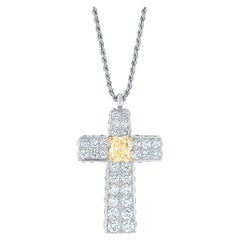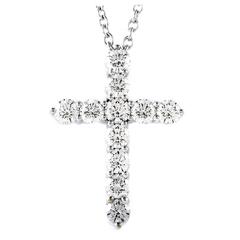Graff Cross
21st Century and Contemporary Pendant Necklaces
Diamond, Yellow Diamond, 18k Gold, White Gold
21st Century and Contemporary English Modern Bracelets
Diamond, 18k Gold, White Gold
Early 2000s Pendant Necklaces
Diamond, Platinum
21st Century and Contemporary British Pendant Necklaces
Diamond, White Gold
Recent Sales
Late 20th Century British Necklace Enhancers
White Diamond, 18k Gold, White Gold
Late 20th Century British Necklace Enhancers
White Diamond, 18k Gold, White Gold
Late 20th Century Pendant Necklaces
Diamond, 18k Gold
21st Century and Contemporary Pendant Necklaces
Diamond, 18k Gold, White Gold
Late 20th Century British Necklace Enhancers
White Diamond, 18k Gold, White Gold
People Also Browsed
21st Century and Contemporary French Modern Pendant Necklaces
Diamond, White Diamond, Platinum
21st Century and Contemporary American Cocktail Rings
Yellow Diamond, 18k Gold, Yellow Gold, Platinum
21st Century and Contemporary American Contemporary Engagement Rings
Diamond, Spinel, Platinum
2010s American Contemporary Band Rings
Diamond, Gold, Platinum
21st Century and Contemporary American Contemporary Choker Necklaces
Diamond, Yellow Diamond, Yellow Gold, Platinum
1990s Italian Corsets
Early 2000s Italian Evening Dresses and Gowns
21st Century and Contemporary Contemporary Loose Gemstones
Pink Diamond
2010s American Pendant Necklaces
Diamond
21st Century and Contemporary Three-Stone Rings
Pink Diamond
Late 20th Century Italian Bangles
18k Gold, Yellow Gold
Early 2000s French Evening Dresses and Gowns
Early 2000s French Evening Dresses and Gowns
21st Century and Contemporary Stud Earrings
Diamond, White Gold
20th Century French Romantic Clip-on Earrings
Diamond, 18k Gold
21st Century and Contemporary American Artist Solitaire Rings
Pink Diamond, Diamond, Platinum
Graff for sale on 1stDibs
The British jeweler Sir Laurence Graff (b. 1938) became utterly mesmerized by diamonds when he undertook his first apprenticeship at age 15 in London’s Hatton Garden jewelry district. It wasn't long before he established his now-celebrated eponymous brand, which produces engagement rings, necklaces, rings, earrings, stand-alone jewels, watches and more — all entirely in-house.
Graff had enrolled in classes at Central School of Arts and Crafts, and while he initially showed promise and was highly regarded, the shop owner, Mr. Schindler — who had his apprentice scrubbing floors and toilets — soon changed his tune, deeming him subpar. Undeterred, Graff learned to repair rings and designed small jewels at a humble workbench in his bedroom. He opened a 24-hour ring-repair service with a business partner and, in 1960, founded his luxury house. Two retail locations followed in London in 1962. Graff would go on to become one of the finest diamantaires in the world and was appointed an OBE in 2013 by Queen Elizabeth for his services to the jewelry industry.
Graff is known for handling some of the most famous diamonds in the world, including the Windsor Yellows, the Paragon, the Lesotho Promise and the Wittelsbach-Graff. He also purchased the 302.37-carat Graff Lesedi La Rona, which, at the time, was the largest diamond ever graded by the Gemological Institute of America. The GIA certified the diamond — then the second-largest gem-quality rough diamond on record — as being of highest color and highest clarity. Lucara Diamond Corporation workers discovered the 1,109-carat rough diamond in 2015 at the Karowe mine in Botswana, and after Graff purchased the diamond in 2017, his gemologists and craftsmen spent more than 18 months polishing its final facets.
While many jewels, such as the Graff Lesedi La Rona, remain in Graff’s collection, he does sell extremely high-quality stand-alone jewels. Gems in his showrooms can reportedly fetch hundreds of thousands of dollars on average. Although these stones are perhaps slightly out of the budget of a typical Graff jewelry client, the house does work with more reasonably priced, but no less exceptional gems for its collections.
Naturally, diamonds feature prominently in Graff jewelry, which is known for being more avant-garde than traditional, although Graff does create classic engagement rings, too. The jeweler’s ready-to-wear collections integrate naturalistic motifs like butterflies, bows and sunbursts, as well as striking silhouettes like the crisscrossed Kiss, the clustered Threads and the swirling Inspired by Twombly line, which pays homage to the work of American painter and sculptor Cy Twombly. And while diamonds are the main focus for Graff, his jewelry occasionally features other precious and semiprecious stones.
Browse Graff watches, rings, earrings and other accessories on 1stDibs.
The Legacy of Diamond in Jewelry Design
Antique diamond rings, diamond tiaras and dazzling vintage diamond earrings are on the wish lists of every lover of fine jewelry. And diamonds and diamond jewelry are primarily associated with storybook engagements and red-carpet grand entrances — indeed, this ultra-cherished gemstone has a dramatic history on its hands.
From “A Diamond Is Forever” to “Diamonds Are a Girl’s Best Friend,” pop culture has ingrained in our minds that diamonds are the most desired, the most lasting and the most valuable gemstone. But what makes the diamond so special? Each stone — whether it’s rubies, sapphires or another stone — is unique and important in its own right. April babies might claim diamonds for themselves, but just about everyone wants this kind of sparkle in their lives!
There are several factors that set diamonds apart from other stones, and these points are important to our gem education.
Diamonds are minerals. They are made up of almost entirely of carbon (carbon comprises 99.95 percent; the remainder consists of various trace elements). Diamonds are the hardest gemstones, ranking number 10 on the Mohs Hardness Scale. Even its name, diamond, is rooted in the Greek adamas, or unconquerable. The only object that can scratch a diamond is another diamond. Diamonds are formed deep within the earth at very high temperatures (1,652–2,372 degrees Fahrenheit at depths between 90 and 120 miles beneath the earth’s surface) and are carried up by volcanic activity. Diamonds are quite rare, according to the Gemological Institute of America, and only 30 percent of all the diamonds mined in the world are gem quality.
In the 1950s, the Gemological Institute of America developed the 4Cs grading system to classify diamonds: clarity, color, cut and carat weight. Not all diamonds are created equal (there are diamonds, and then there are diamonds). The value of the diamond depends on the clarity (flawless diamonds are very rare but a diamond's value decreases if there are many blemishes or inclusions), color (the less color the higher the grade), cut (how the diamond’s facets catch the light, certain cuts of diamonds show off the stone better than others) and carat weight (the bigger, the better).
When you start shopping for a diamond engagement ring, always prioritize the cut, which plays the largest role in the diamond's beauty (taking the time to clean your diamond ring at least every six months or so plays a role in maintaining said beauty). And on 1stDibs, a range of buying guides can be found for those in the market for antique engagement rings, vintage engagement rings or Art Deco engagement rings.
Shop antique and vintage diamond rings, diamond necklaces and other extraordinary diamond jewelry on 1stDibs.
Finding the Right Necklaces for You
We are fortunate to know much of the world’s long and dazzling history of necklaces, as this type of jewelry was so treasured that it was frequently buried with its owners. Today, Van Cleef necklaces, Tiffany necklaces and Cartier necklaces are some of the most popularly searched designer necklaces on 1stDibs.
Lapis lazuli beads adorned necklaces unearthed from the royal graves at the ancient Iraqi civilization of Sumer, while the excavation of King Tut’s burial chamber revealed a sense of style that led to a frenzy of Art Deco designs, with artisans of the 1920s seeking to emulate the elegant work crafted by Ancient Egypt’s goldsmiths and jewelry makers.
In ancient times, pendant necklaces worn by royalty and nobles conferred wealth and prestige. Today, wearing jewelry is about personal expression: Luxury diamond necklaces exude confidence and can symbolize the celebratory nature of a deep romantic relationship, while paper-clip chain-link necklaces designed by the likes of goldsmith Faye Kim are firmly planted in the past as well as the present. Kim works exclusively with eco-friendly gold, and these fashionable, fun accessories owe to the design of 19th-century watch fobs.
For some, necklaces are thought of as being a solely feminine piece, but this widely loved accessory has been gender-neutral for eons. In fact, just as women rarely took to wearing a single necklace during the Renaissance, men of the era layered chains and valuable pendants atop their bejeweled clothing. In modern times, the free-spirited hippie and counterculture movements of the 1960s saw costume-jewelry designers celebrating self-expression through colorful multistrand necklaces and no shortage of beads, which were worn by anyone and everyone.
Even after all of these years, the necklace remains an irrefutable staple of any complete outfit. Although new trends in jewelry are constantly emerging, the glamour and beauty of the past continue to inform modern styles and designs. In a way, the cyclical history of the necklace differs little from its familiar looped form: The celebrated French jewelry house Van Cleef & Arpels found much inspiration in King Tut, and, now, their Alhambra collection is a go-to for modern royals. Vintage David Webb necklaces — whose work landed him on the cover of Vogue in 1950, two years after opening his Manhattan shop — were likely inspired by the ornamental styles of ancient Greece, Mesopotamia and Egypt.
On 1stDibs, browse top designers like Dior, Chanel and Bulgari, or shop by your favorite style, from eye-catching choker necklaces to understated links to pearl necklaces and more.
- Is Graff worth it?1 Answer1stDibs ExpertSeptember 16, 2024Yes, many jewelry lovers believe that Graff is worth it. Graff is known for handling some of the most famous diamonds in the world, including the Windsor Yellows, the Paragon, the Lesotho Promise and the Wittelsbach-Graff. Naturally, diamonds are featured prominently in Graff jewelry, which is known for being more avant-garde, although Graff creates classic pieces, too. The jeweler’s ready-to-wear collections integrate motifs like butterflies, bows and sunbursts, as well as striking silhouettes like the crisscrossed Kiss, the clustered Threads and the swirling Inspired by Twombly line, which pays homage to the work of American painter and sculptor Cy Twombly. However, whether or not it’s worth investing in Graff jewelry is totally subjective! At 1stDibs, we believe in buying what you love. Our shopping experience enables discovery and learning, whether you are a seasoned connoisseur or just beginning your collection. Find Graff jewelry and other jewelry on 1stDibs.





